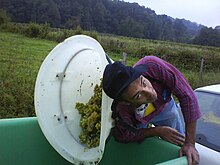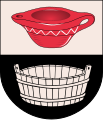Bucket
The bucket , the butte , the Bütt ( etymologically related to the vat ), the tub (derived from the Old High German word “zwi-bar”, literally “two-carrier”, which means a vessel with two handles, in contrast to Old High German one. beri, bucket , with a handle) or (Upper German) the sheep is a large vessel of round or oval shape without a lid. Usually these vessels are wider than they are high.
Bütten are traditionally used in paper production ( scoop ) or in viticulture . Originally, however , the washtub was used as a general sanitary utensil. "Zuber" is the name given here to specially heated vessels.
history
Were initially handmade paper made of wood and were similar to the closed wine barrels by the coopers , Büttner or coopers made. Later the chutes were also made of stone or iron ; the iron ones were clad with lead to protect them from rust . Up until the 18th century, a paper mill usually only had a single vat, which then determined the limit of its performance.
In the Rhenish and Southwest German regions, where carnival and carnival play a major role, the "Bütt", borrowed from viticulture, was converted into a lectern for hand-made speeches . In the meantime, this - now artistically designed - Bütt is no longer suitable for holding liquids, because an access similar to a pulpit was created from behind .
use
Washtub

In the past, tubs or laid paper for the purpose of washing clothes stood in the washhouses , which were usually shared by several parties and had an oven for heating the water. In addition, the washtub also forms the initial shape of the bathtub for body care. In the southern Palatinate , the bathtub is still colloquially called "Badbütt".
Papermaking
Handmade paper are still used in the production of handmade paper, the hand-made paper , the short also the deckle is called. An aqueous pulp of rags or cellulose (the whole fabric or the whole material ) is scooped out with a sieve and then dried to paper. A bucket from paper-making is also used in the historical custom of couching when a book printer or typesetter or typesetter is accepted into the journeyman's class after completing his apprenticeship .
Viticulture
In viticulture, large hand-made vats, also known as grape vats or tubs, are used by the vintner to collect and transport the grapes during the grape harvest , and also temporarily to store grapes, mash or must .
The Bütte, also Beschoff, is to be distinguished from the Hotte , Kiepe , Legel or Logel , in Baden also Biggi and Traubenschütte . This vessel is a container carried on the back by means of two leather straps . This was once a woven basket (back box) sealed with pitch, then a container made of zinc sheet , more rarely copper sheet; more recently it is made of plastic. During the harvest by hand, it is used to transport the grapes from the vineyard to the transport vat, with a capacity of up to 40 kg of grapes or 75 liters of liquid.
Construction
Nowadays the term Bütt is also used by craftsmen. For them, it is a large vat, usually made of sturdy plastic , which is an all-purpose vessel for a wide variety of construction tasks. It is used, for example, to wash tools or to mix mortar .
heraldry
The (bath) -Zuber is a common figure in heraldry that is not only used in bathing resorts .
The Swabian housewife washes in Wäschenbeuren
Bad Gögging coats of arms with Badescheffel from different epochs
Baden (Lower Austria) with bathers
Web links
Individual evidence
- ↑ Rudolf Schützeichel: Old High German Dictionary . 3. Edition. Tübingen 1981, p. 249
- ↑ Beschoff . In: Prussian Academy of Sciences (Hrsg.): German legal dictionary . tape 2 , issue 1 (edited by Eberhard von Künßberg ). Hermann Böhlaus successor, Weimar ( adw.uni-heidelberg.de - publication date 1932 or 1933).
- ↑ Kupferbütte picture
- ↑ Beschoff, vat, Hotte, Legel and Logel








